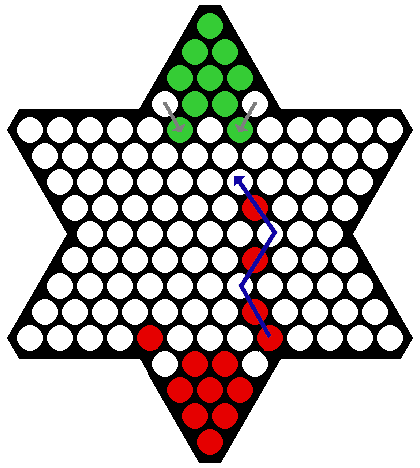
Each triangle is a different colour and there are six sets of ten balls (or pegs) with corresponding colours. The interior of the board is a hexagon with each side five holes long. Each point of the star is a triangle consisting of ten holes (four holes to each side). The Chinese Checkers board is in the shape of a six pointed star.

Note how many of the Chinese Checkers computer games on this site who comes from Germany are always named Halma. An interesting question is why Halma is still favored in many European countries (especially in Germany) while almost disappeared in others and replaced with Chinese Checkers? Remember also that Chinese Checkers is called Halma many places (again especially in Germany).The Milton Bradley Company got a patent on Chinese Checkers thirteen years later (1941). Many were given other names but since no one seemed to own the rights to the name many were just called Chinese Checkers.

Several other manufactures started to make the game. In the 1930s a craze for Chinese Checkers swept across America.The game was given a Chinese name and theme in keeping with the current interest in all things oriental (among them the discovery of King Tut's tomb in 1922 and the 'mah jongg' game that was introduced in 1923). The brothers Bill and Jack Pressman made up the name 'Chinese Checkers' during or shortly after 1928. This was exact the same game as the 1892 Star-Halma. The first Chinese Checkers game to be published in the United States was 'Hop Ching Checkers' in 1928 by J.Spears & Sons introduced the star board to England in 1909. The first game of Chinese Checkers was published and patented by the German game company Ravensburger (Otto Robert Maier) under the name Stern-Halma (stern means star in English Star-Halma) in 1892.In a two-player game many prefers to play with 15 pieces each. In some modern versions for children the board is smaller and the player have only six pieces each. Each player has only 10 pieces each and the distance to the opponents home arena is fewer spaces away than in standard Halma. Chinese Checkers is based on Halma and the only difference is that it is played on a six-pointed star-shaped game board and then can be played by 2 to 6 players.The game winner wins by occupying all the vacant holes of the opposing triangle. However, there are anti-spoiling rules which claim these pegs do not inhibit players from winning. Some rules claim it is legal to block players with your pegs in their home triangle. When a peg reaches the opposite triangle across the board it cannot be moved out, only within that triangle. Players are permitted to hop over as many pegs as possible in a single turn. Hopping moves must be to adjacent and empty holes. Players may move pegs into holes adjacent to the starting hole or jump over pegs. Players alternate turns moving single pegs. The unused pegs are left to the side so they are not used in the game. Players each choose a color and its 10 corresponding pegs. Three player games use the triangles equidistant from each other.

Four player games should be played with two pairs of opposite triangles, two players games should always be played with opposing triangles. A six player game uses all the pegs and triangles. The game can accommodate 2, 3, 4, or 6 players. Play continues until all players place, i.e. Players use single step moves and jumps to win. The goal of the game is to move all of one’s pieces across the hexagonal board to the “home,” which is a corner across the board from a player’s starting corner. It is a simpler version of the game Halma, which is an American game. Despite the name, the game actually originated in Germany, where it was called Sternhalma. Chinese Checkers is a strategy board game.


 0 kommentar(er)
0 kommentar(er)
